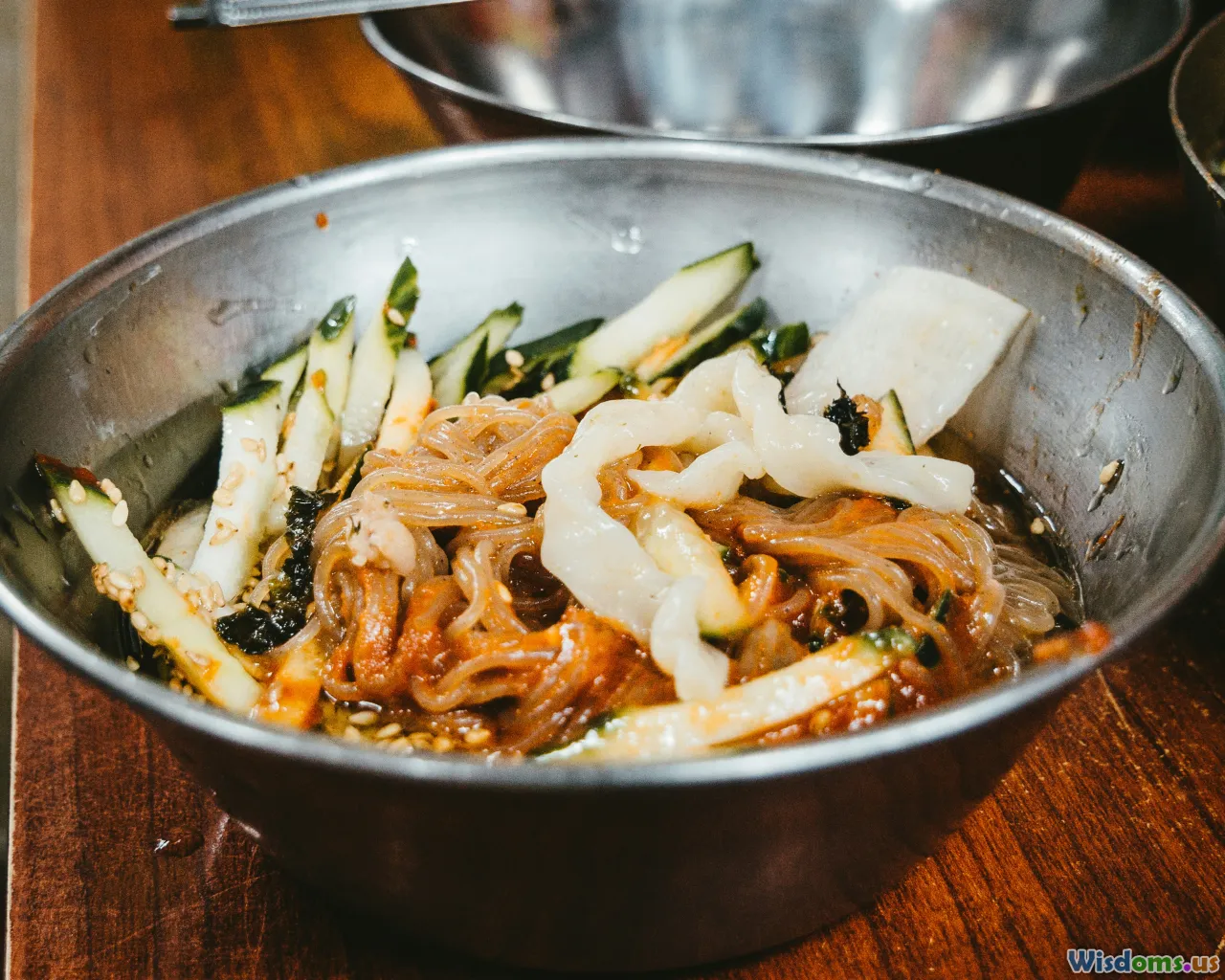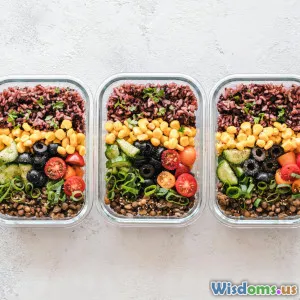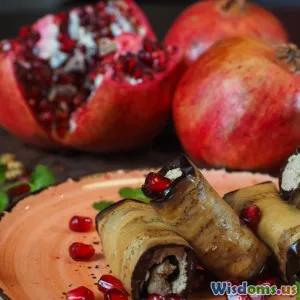
Kimchi Versus Sauerkraut: Which Ferment Wins?
15 min read Discover a detailed comparison of kimchi and sauerkraut, delving into their nutrition, history, flavor, and health benefits to reveal the ultimate fermented food champion. (0 Reviews)
Kimchi Versus Sauerkraut: Which Ferment Wins?
The battle of fermented foods has been bubbling beneath the surface of global cuisine for centuries. From European kitchens to Asian tables, two champions dominate the world of tangy, probiotic-rich eats: kimchi and sauerkraut. Both have loyal followers, celebrated legacies, and healthy reputations, but which truly claims the throne as the king of ferments? In this article, we pit kimchi against sauerkraut, weighing culture, flavor, nutrition, and health benefits, to decide which ferment deserves pride of place on your plate.
Table of Contents
- Introduction: The Rise of Fermented Foods
- Origins: Tradition on Two Continents
- Core Ingredients and Preparation
- Taste Test: Flavors and Textures Unpacked
- Nutritional Face-Off: Micronutrients, Macros, and More
- Probiotics and Digestive Health
- Culinary Uses: Flexibility in the Kitchen
- Cultural Impact and Popularity
- The Verdict: Is There a Winner?
Introduction: The Rise of Fermented Foods
Can a humble handful of cabbage really ignite a culinary revolution? In recent years, the answer appears to be a resounding “yes.” As we witness a global wellness wave, fermented foods like kimchi and sauerkraut have gone from cultural curiosities to staples at health-conscious tables. Their tang and punch—fueled by beneficial bacteria—promise gut good, unique flavors, and a history as rich as their taste. But, as their jars jockey for space in both supermarket aisles and wellness blogs, curiosity beckons: when stacked head-to-head, is it kimchi or sauerkraut that’s set to rule?
Origins: Tradition on Two Continents
Kimchi: Korea's Ancient Culinary Treasure
Kimchi’s story begins over two millennia ago in Korea. Rooted in the need to preserve vegetables for long winters, the word “kimchi” even comes from an ancient Korean term meaning “steeped or submerged vegetable.” Early versions were simply salted vegetables. Over time, as red chili peppers arrived in Korea in the 16th century, the kimchi we know today—zesty, spicy, and brimming with garlic and ginger—emerged.
Today, over 200 varieties exist, ranging from the classic baechu (napa cabbage) kimchi, to radish and cucumber-based options. Families in Korea still gather each kimjang (kimchi-making season) to prepare enough jars to last the year, a tradition recognized by UNESCO for its cultural significance.
Example: In 2013, kimjang—Korea’s annual kimchi-making event—was designated a UNESCO Intangible Cultural Heritage, highlighting kimchi’s importance beyond cuisine and into community identity.
Sauerkraut: Preservation by the Barrel
Sauerkraut, literally “sour cabbage” in German, is a product of European food ingenuity. Cabbage has been cultivated in Europe since at least the Roman Empire, and fermenting it in brine was the primary way to preserve it through harsh winters. While Heinrich Heine, a famed poet, once joked that “vegetarians eat sauerkraut so they do not die of monotony,” this ferment has supported armies (notably Prussian and Russian) by providing vital vitamin C, combatting the scourge of scurvy.
Example: Captain James Cook notably stocked impressively large quantities of sauerkraut on his voyages—enough to nourish his crew on long expeditions and help keep scurvy at bay.
Core Ingredients and Preparation
The Basics
- Kimchi: Usually consists of napa cabbage, radishes, scallions, garlic, ginger, Korean chili powder (gochugaru), and fish sauce or salted shrimp. Vegetarian versions omit seafood. The vegetables are salted, drained, coated in a spice paste, and then fermented in a jar for several days to weeks.
- Sauerkraut: Simplicity itself—just shredded white or green cabbage and salt. The two are massaged together, packed into a container, and “krauted” as lactic acid bacteria transform the cabbage into tangy sauerkraut over one to three weeks.
Fermentation Mechanics
Both depend on lactic acid fermentation. Wild lactic acid bacteria consume sugars and convert them to lactic acid, which imparts tang and preserves the vegetables. However, kimchi’s bolder seasoning blend and variable ingredients yield greater complexity in both flavor and bacterial strains.
Taste Test: Flavors and Textures Unpacked
Kimchi: A Firework of Flavors
Kimchi’s sensory profile is a festival. Expect:
- Spiciness: Thanks to gochugaru and fresh aromatics, many kimchis are vibrantly spicy, though mild versions exist.
- Umami: Fish sauce, shrimp, and fermentation itself build deep, savory notes.
- Garlic and Ginger: The signature pungency sets kimchi apart from almost any other ferment.
- Crunchiness: Well-made kimchi remains crisp yet yielding, with brine that’s both mouthwatering and refreshing.
Real-world insight: David Chang, famed chef and founder of Momofuku, credits kimchi as his “flavor secret weapon,” using it to boost everything from burgers to fried rice.
Sauerkraut: Subtlety and Sourness in Harmony
Sauerkraut is all about simplicity and refreshment:
- Tartness: Its classic tang comes from pure lactic acid, with no added spices.
- Cabbage-forward flavor: Natural sugars convert but the essence of cabbage remains.
- Soft texture: While it can stay quite crunchy, especially home-brewed versions, commercial kraut is often softer and more sour.
Fun fact: German cuisine often pairs sauerkraut with fatty sausages and pork as a palate cleanser, balancing heaviness with acidity.
Nutritional Face-Off: Micronutrients, Macros, and More
Macronutrients and Calories
Both kimchi and sauerkraut are remarkably low in calories and fats, making them excellent companions to calorie-conscious meals. Their primary nutrients come from cabbage—fiber, vitamin C, and, in the case of kimchi, added benefits depending on tossed-in vegetables like carrots or radishes.
- Calories per serving (~100g):
- Kimchi: ~15-25 kcal
- Sauerkraut: ~20 kcal
- Fat: Both are virtually fat-free, unless non-traditional ingredients are added.
Micronutrients
- Kimchi:
- High vitamin C, vitamin K, folate.
- Garlic and chili add antioxidants, vitamin A, and anti-inflammatory compounds.
- Fish sauce versions contain B vitamins and minerals.
- Sauerkraut:
- Excellent source of vitamin C.
- Reasonable vitamin K.
- Small amounts of B vitamins, calcium, iron.
Sodium Concerns
Both can be salty due to their preservation process. A 100g portion of kimchi contains ~500mg sodium; sauerkraut ~700mg. While manageable for most, those on low-sodium diets should portion appropriately.
Quote:
“Fermented vegetables like sauerkraut and kimchi are packed with vitamins, but they’re also salty! Enjoy, but use moderation if hypertension is a concern.” — Dr. Michael Greger, author of ‘How Not to Die’
Antioxidants and Phytochemicals
Kimchi’s blend of ingredients offers a wider array of antioxidants, largely from red pepper, garlic, and ginger. Studies indicate kimchi may help modulate inflammation through compounds like allicin (from garlic) and capsaicin (from chili peppers). Sauerkraut’s cabbage content makes it an excellent source of glucosinolates, compounds studied for cancer-preventive effects.
Probiotics and Digestive Health
The Power of Fermented Bacteria
-
Kimchi: Studies from South Korea have identified up to 200 different strains of beneficial lactobacilli in traditionally fermented kimchi, often including Lactobacillus plantarum, Leuconostoc mesenteroides, and diverse wild yeasts. These promote digestive balance, support immune function, and may even contribute to reduced cholesterol levels and improved metabolic health. Some research also suggests specific kimchi bacterial strains may combat pathogens such as E. coli.
-
Sauerkraut: Home-fermented kraut teems with L. mesenteroides, L. plantarum, and Pediococcus species. Research in the journal Frontiers in Microbiology found sauerkraut offers a comparably potent probiotic profile when unpasteurized and untreated; pasteurized store-bought versions, however, lose most live probiotics.
Which is Better for Your Gut?
Variety is king. Kimchi’s multicultural vegetable mix fuels a neuronal web of good bacteria, while fresh, unpasteurized sauerkraut is wonderfully rich in well-studied strains like L. plantarum. Choosing both helps diversify your microbiome—a key for lasting gut health.
Culinary Uses: Flexibility in the Kitchen
The Role of Kimchi
Kimchi is more than just a side. In Korea, it’s an essential building block for stews (kimchi jjigae), pancakes (kimchi jeon), dumplings (kimchi mandu), and fried rice. Its punchy character enhances even Western favorites—think burgers and grilled cheese. The rise of fusion cuisine has seen kimchi tacos, kimchi pasta, and even kimchi-topped avocado toast spike in popularity.
Example: Los Angeles’ gourmet food trucks introduced “Kogi Tacos”—Korean BBQ beef with kimchi on soft tortillas—turning heads and palates across the United States.
Sauerkraut on the Table
Traditionally, sauerkraut stars alongside pork, sausages (bratwurst), and potatoes in Germanic cuisine. It’s also the tang behind classic Reuben sandwiches and a staple topping for hot dogs in North America. New-wave dishes, like sauerkraut salad or kraut pierogies, showcase its potential for modern veggie-forward meals.
Tip: Mix a spoonful of sauerkraut into salads, or blend it with apple and caraway for a fast, gut-friendly slaw.
Cultural Impact and Popularity
Kimchi Goes Global
In the last decade, kimchi has stormed culinary charts worldwide. From K-pop to cooking shows, Korea’s global cultural wave—known as "Hallyu"—has kindled Western interest in all things Korean, including its spicy staple. Supermarkets in New York and London now stock imported and locally made kimchis alike, reflecting its integration into mainstream eating.
A 2018 report by the Korea Agro-Fisheries & Food Trade Corporation found kimchi exports hit a historic high, exceeding $67 million globally that year.
Sauerkraut’s Staying Power
Sauerkraut may lack the glamour of global pop stardom, but its longevity speaks for itself. It endures as a comfort food, a health food, and a culinary building block. Though associated with Germany, variants of kraut exist in Poland (kapusta kiszona), Russia, and the Balkans—proof of its pan-European appeal.
The craft fermentation trend has led to boutique sauerkrauts, flavored with turmeric, juniper, or beet. According to the Specialty Food Association, U.S. sales of specialty sauerkraut products grew 9% from 2015–2019.
The Verdict: Is There a Winner?
If you came here hoping for a single winner, you may be surprised: kimchi and sauerkraut each shine in distinct arenas. For those craving explosive flavor, diverse textures, and bold health claims, kimchi easily steals hearts (and palates). Its probiotic content, antioxidant richness, and culinary adaptability are unmatched.
Yet sauerkraut’s modest ingredient list conceals probiotic power, crucial historical legacy, and elegant utility. Its mild taste accommodates many palates, especially the fermented-food novice, and it is widely accessible and easy to make at home—even for first-time fermenters.
Try both! Alternate between the zesty kick of kimchi and the clean tang of sauerkraut. By diversifying your plate, you diversify your microbiome, sample the world’s culinary heritage, and gain the nutritional bounty of both cultures.
Take Action:
- Make your own batch at home (try small mason jars)
- Pick an unpasteurized version for probiotic benefit
- Gradually work small servings into meals (fried rice, salads, sandwiches)
- Share or participate in a kimchi- or sauerkraut-making session—many local cooking stores offer virtual workshops!
Final thought: These aren’t just condiments—they are living links to ancient wisdom, flavor-packed bridges between continents and generations, and proof that the old can indeed be very new again.
References
- Odell, A. (2021). Fermentation as Metaphor. Chelsea Green Publishing.
- Journal of Ethnic Foods: "Fermented vegetables as sources of beneficial bacteria"
- Korea Agro-Fisheries & Food Trade Corporation: 2018 Korean Food Export Data.
- Dr. Michael Greger (2017) – How Not to Die.
- Frontiers in Microbiology: "Lactic acid bacteria in fermented cabbage products"
Ready to take a bite out of tradition? Whether spicy or sour, your next meal can be both a delicious culinary adventure and a wholesome gift to your gut.
Rate the Post
User Reviews
Popular Posts















